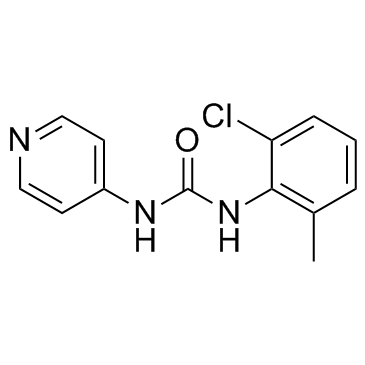N-(2-Chloro-6-methylphenyl)-N'-4-pyridinylurea
Modify Date: 2024-01-15 12:56:33

N-(2-Chloro-6-methylphenyl)-N'-4-pyridinylurea structure
|
Common Name | N-(2-Chloro-6-methylphenyl)-N'-4-pyridinylurea | ||
|---|---|---|---|---|
| CAS Number | 97627-24-2 | Molecular Weight | 261.70700 | |
| Density | N/A | Boiling Point | N/A | |
| Molecular Formula | C13H12ClN3O | Melting Point | N/A | |
| MSDS | N/A | Flash Point | N/A | |
Use of N-(2-Chloro-6-methylphenyl)-N'-4-pyridinylureaN-[(1R)-4-[(Aminoiminomethyl)amino]-1-[[[(1R)-1-(4-hydroxyphenyl)ethyl]amino]carbonyl]butyl]-α-phenylbenzeneacetamide is an anticonvulsant agent with potential for the treatment of generalized tonic-clonic and partial seizures. |
| Name | 1-(2-chloro-6-methylphenyl)-3-pyridin-4-ylurea |
|---|---|
| Synonym | More Synonyms |
| Description | N-[(1R)-4-[(Aminoiminomethyl)amino]-1-[[[(1R)-1-(4-hydroxyphenyl)ethyl]amino]carbonyl]butyl]-α-phenylbenzeneacetamide is an anticonvulsant agent with potential for the treatment of generalized tonic-clonic and partial seizures. |
|---|---|
| Related Catalog | |
| In Vivo | Compound shows anticonvulsant activity at 30 mg/kg in the initial tests with no signs of ataxia until 300 mg/kg. The activity seen with 30 mg/kg 37 is still present 4 h postdose. Compound is effective against seizures induced by maximal electroshock but does not protect mice from clonic seizures produced by the convulsant pentylenetetrazol. The overall pharmacological profile suggests that Compound would be of therapeutic use in the treatment of generalized tonic-clonic and partial seizures. Compound is selected for clinical trials[1]. |
| Animal Admin | Mice: Five mice are tested at each of three doses (30,100, and 300 mg/kg) and three times (0.5, 2, and 4 h). The mice are subjected to electrical current delivered through ear clips for 0.2 s (90 mA, 1-ms monophasic pulses at 100 Hz). This current strength is approximately 4 times that required to produce seizures in 99% of mice and reliably produce seizures in 100% of control mice. Prevention of tonic hind limb extension is taken as an anticonvulsant effect. Behavioral side effects are measured in mice[1]. |
| References |
[1]. Pavia MR, et al. N-Phenyl-N'-pyridinylureas as Anticonvulsant Agents. J. Med. Chem. 1990,33, 854-861 |
| Molecular Formula | C13H12ClN3O |
|---|---|
| Molecular Weight | 261.70700 |
| Exact Mass | 261.06700 |
| PSA | 60.74000 |
| LogP | 3.12290 |
|
~78% 
N-(2-Chloro-6-m... CAS#:97627-24-2 |
| Literature: Pavia; Lobbestael; Taylor; Hershenson; Miskell Journal of Medicinal Chemistry, 1990 , vol. 33, # 2 p. 854 - 861 |
| Precursor 2 | |
|---|---|
| DownStream 0 | |
| Urea,N-(2-chloro-6-methylphenyl)-N'-4-pyridinyl |
| N-(2-CHLORO-6-METHYLPHENYL)-N'-(PYRIDIN-4-YL)UREA |
| N-(2-chloro-6-methylphenyl)-N'-4-pyridinyl urea |
| N-(2-Chloro-6-methylphenyl)-N'-4-pyridinylurea |

